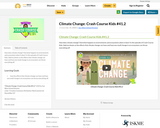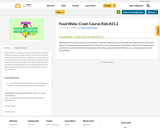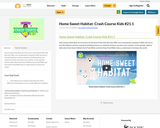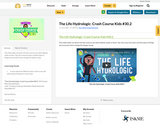
Students will explore the process of biofuel production and how it relates to food chains.
- Subject:
- Agriculture Studies
- Material Type:
- Activity/Lab
- Lesson
- Provider:
- Iowa Agriculture Literacy Foundation
- Author:
- James Sleep
- Date Added:
- 10/11/2018

Students will explore the process of biofuel production and how it relates to food chains.

How does climate change? And what happens to environments and ecosystems when it does? In this episode of Crash Course Kids, Sabrina shows us the effects that climate change can have and how one small change in an ecosystem can throw everything off.

Is the food chain shown above accurate? Does the first link depict a producer, the second link a herbivore, and the third link an omnivore / carnivore? Students must correctly determine whether a species is a producer or consumer, and what type of consumer; herbivore, omnivore, or carnivore. Students are provided with a list of Sonoran Desert species and asked to construct, within their groups, several food chains. These food chains are then be used to construct a food web. In order to complete this activity, students must first research the individual species to understand their feeding habits.

In this episode of Crash Course Kids, Sabrina talks about the way energy moves, or flows, through an ecosystem and how that movement forms Food Chains!

With a continued focus on the Sonoran Desert, students are introduced to the concepts of food chains and food webs through a PowerPoint® presentation. They learn the difference between producers and consumers and study how these organisms function within their communities as participants in various food chains. They further understand ecosystem differences by learning how multiple food chains link together to form intricate and balanced food webs. At lesson end, students construct food webs using endemic desert species.

We know that if we take an animal out of its habitat, it will have a difficult time surviving. We also know that there's a lot more going on in ecosystems than just temperature. In fact, there are so many elements in ecosystems, that if just one leaves or gets out of whack, it can be terrible for the whole thing. This video examines how Spider Monkeys are a vital component of a rain forest habitat and what would happen if they weren't part of the ecosystem.

Students learn about energy flow in food webs, including the roles of the sun, producers, consumers and decomposers in the energy cycle. They model a food web and create diagrams of food webs using their own drawings and/or images from nature or wildlife magazines. Students investigate the links between the sun, plants and animals, building their understanding of the web of nutrient dependency and energy transfer.

Students learn about energy and nutrient flow in various biosphere climates and environments. They learn about herbivores, carnivores, omnivores, food chains and food webs, seeing the interdependence between producers, consumers and decomposers. Students are introduced to the roles of the hydrologic (water), carbon, and nitrogen cycles in sustaining the worlds' ecosystems so living organisms survive. This lesson is part of a series of six lessons in which students use their growing understanding of various environments and the engineering design process, to design and create their own model biodome ecosystems.

The Great Pacific Garbage Patch (GPGP) is an intriguing and publicized environmental problem. This swirling soup of trash up to 10 meters deep and just below the water surface is composed mainly of non-degradable plastics. These plastic materials trap aquatic life and poison them by physical blockage or as carriers of toxic pollutants. The problem relates to materials science and the advent of plastics in modern life, an example of the unintended consequences of technology. Through exploring this complex issue, students gain insight into aspects of chemistry, oceanography, fluids, environmental science, life science and even international policy. As part of the GIS unit, the topic is a source of content for students to create interesting maps communicating something that they will likely begin to care about as they learn more.

In this lesson, the students will investigate what types of plants and insects they could eat to survive in the Amazon. They will research various plants and/or insects and identify characteristics that make them edible or useful for the trip. The students will create posters and present their findings to the class.

How would a Polar Bear do if you put it in the desert? Not well. But why? Why can't anything live anywhere? Well, this has to do with Habitats and how animals (including humans) are suited for living in one place over another. In this episode, Sabrina talks about how these Habitats form Food Webs and how those Food Webs help us understand a lot about the world.

This video takes use down into the ocean to see what habitats await us there. Yep, the ocean has layers and the types of things we encounter there change the deeper we go.

Students gain an understanding of the parts of a plant, plant types and how they produce their own food from sunlight through photosynthesis. They also learn about transpiration, the process by which plants release moisture to the atmosphere. With this understanding, students test the effects of photosynthesis and transpiration by growing a plant from seed. They learn how plants play an important part in maintaining a balanced environment in which the living organisms of the Earth survive. This lesson is part of a series of six lessons in which students use their evolving understanding of various environments and the engineering design process, to design and create their own model biodome ecosystems.

Every week Science North will provide Grade 4 teachers with a pre-recorded video and printable resource.
Teachers will be able to share these YouTube videos and resources with students weekly.
Included are classroom videos, student handouts, and offline lesson plans.
These videos and handouts can be sent to students to provide them with key concepts and activities that link to the curriculum.

Marine biologist Tierney Thys teamed with Christian Sardet (CNRS/Tara Oceans), No錩 Sardet and Sharif Mirshak to use footage from the Plankton Chronicles project to ignite wonder and curiosity about the hidden world of Plankton that underpins our own food chain. A quiz, thought provoking question, and links for further study are provided to create a lesson around the 6-minute video. Educators may use the platform to easily "Flip" or create their own lesson for use with their students of any age or level.

Echolocation is the ability to orient by transmitting sound and receiving echoes from objects in the environment. As a result of a Marco-Polo type activity and subsequent lesson, students learn basic concepts of echolocation. They use these concepts to understand how dolphins use echolocation to locate prey, escape predators, navigate their environment, such as avoiding gillnets set by commercial fishing vessels. Students will also learn that dolphin sounds are vibrations created by vocal organs, and that sound is a type of wave or signal that carries energy and information especially in the dolphin's case. Students will learn that a dolphin's sense of hearing is highly enhanced and better than that of human hearing. Students will also be introduced to the concept of by-catch Students will learn what happens to animals caught through by-catch and why.